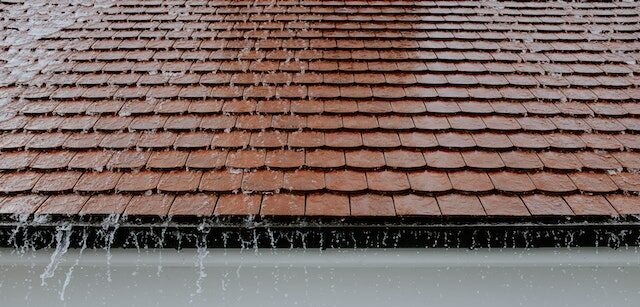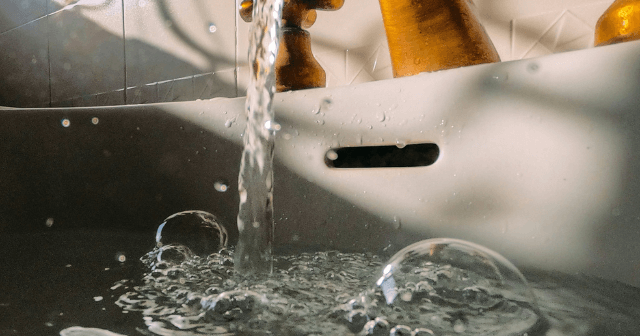Your roof is an essential but underappreciated component of your home: it protects the structure from vicious elements, and it also provides essential insulation that keeps the internal temperature nice and cool. That’s why it’s imperative that you keep your building’s roof in great condition, learning to identify potential problems and knowing who to contact for help.
One insidious issue you might face with your roof is water damage, especially given that Portland gets an average of 35 inches of rain per year. As the first point of contact between the weather and your home, the roof gets the brunt force of all this precipitation, and it can easily suffer serious water damage over time.
What does water damage on the roof look like? How can you identify it faster, and who should you call for help? We’ll address all of these questions in this article so that you’re ready and able to get your home the help it needs at the first sign of trouble.
Roof water damage starts outside
The first signals of roof damage will, quite reasonably, appear on the roof of your home, where water will begin to wash away the protective barriers between your interior and exterior. The shingles, which are the outermost layer of a roof, will be the first to be damaged: you might notice buckled, cracked, or warped shingles, or some may be missing entirely.
Your shingles are covered with a fine grain that is meant to provide them with better weather resistance, but they will gradually loosen and be worn away as the roof ages. Often, these tiny granules will end up in the gutter, where they will look like sand; this tells you that the shingles are no longer holding up well against the elements and should be replaced.
Speaking of the gutter, a clogged gutter can exacerbate water damage to the exterior and interior of the house, leading to liquid spilling onto and under the siding. If you notice that there’s a lot of debris in the gutter or that the downspout is not working properly, you need to get it cleaned and perhaps replaced.
The last thing on the exterior of the home to note involves the flashing: these are the strips of material that protect more vulnerable areas like around chimneys, vents, and skylights. Broken, missing, or dented flashing will allow water to seep in, and you’ll need to take a good look at the underside of your roof to identify water damage.
Advanced damage will begin to appear inside your home as well
As the roof becomes more permeable and less able to protect the interior of your home, you will begin to notice damp patches, puddles, stained insulation, and drips in the attic of the home. Damp insulation is a particular concern because it can easily turn into a breeding ground for all manner of bacteria and fungi that will circulate all throughout your home. If unaddressed, the water will continue to seep downward from the attic, eventually invading the more frequented areas of your home.
Exterior walls may develop damp spots and streaks where water is dripping and trickling; there may be patches of crumbling drywall or peeling paint as the liquid infiltrates the material and begins to break it down. Look closely for efflorescence, which is a white streak of particulates that the water has carried down as it evaporates. This is a tell-tale sign of water damage as it cannot occur without significant moisture.
With advanced water damage cases, you’ll start to notice a damp, musty odor as mold feasts on the moisture and materials of your walls. This should warrant an immediate investigation of your entire home from that level up, because you need to know exactly where the leak is coming from in order to prevent further mold growth. It’s easy to assume that this problem comes from a leaky pipe or something more local, but it may be a symptom of a far more insidious issue: only an expert water damage remediation team can tell.
Inspect your home regularly, and call water damage remediation teams when you suspect an issue
Water damage on the roof can quickly become a serious issue, especially given Portland’s damp climate, so you need to identify and address any concerns as soon as possible. You should schedule regular roof inspections, where a professional can take a good look at the entire roof system and alert you to any repairs that might be necessary. The qualified personnel will hunt for broken or missing roof tiles, sagging or uneven areas of the roof, broken flashing, and dark spots that suggest stains.
On your own, be sure to check the attic regularly, shining a light up onto the ceiling to check for drips and leaks. Watch ceilings and walls for discoloration, stains, or soft areas where the drywall has been compromised. If you identify a musty odor or see any mold, you should assume water damage inside the walls or trickling down from the roof itself.
Roofs – especially roofs that may be compromised by water damage – should always be left to expert Portland water damage restoration companies, who have the knowledge and tools necessary to handle the job safely. Once they arrive, the professional remediation teams will assess the extent of the problem, recommend fixes, and ensure that all side effects of water damage, such as mold, have been eliminated. If they don’t have roofing contractors on their team, they can recommend another company that you can trust to work on that aspect of the case.
Vigilance is key in keeping your home safe
While it’s important that you keep all parts of your home in good repair, the roof is one of the most vital components in preventing extensive water damage in the rest of the house. However, it’s also incredibly vulnerable to water damage because of its location, so you need to pay close attention to the status of your roof through regular inspections and prompt attention to any growing issues. Should you ever suspect water damage in the roof or any other area of the home, don’t delay: get in touch with an expert in remediation as soon as possible.


